|
DMZ
|
|||||||
|
The day, as did all our days in North Korea, started early. We were down in Dining Room 2 by 7am for a quick breakfast and then onto the bus for the three hour trip south to the DMZ. Most of us had been to the DMZ before from South Korea and the chance to visit from the opposite side was one of the more intriguing parts of the whole trip. The idea of being only an hour away from my home in downtown Seoul, yet having no way of going there without first flying off to China just seemed surreal. I was going to be within about 15 minutes of one of my best friend's houses yet trying to go there would cause an international incident and probably get me shot. Even trying to make a call on the cell phone I had smuggled along expressly for this purpose could have gotten me into a lot of trouble. The trip to the Kimland - Real World border was to prove quite memorable. |
|||||||
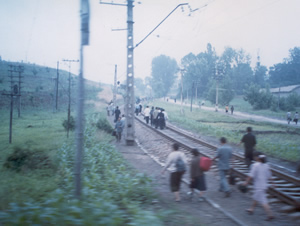 Morning Commute Photo courtesy Brian Stuart |
As we were leaving Pyongyang that morning we could see people heading off to work, many by bus and trolley, but also quite a few on foot. Here you can see groups of people following the railroad tracks out of town to their work sites. The picture here was taken surreptitiously. The guides weren't too happy about us taking pictures of things they thought might embarrass their country and this is a good example. A few seconds after taking this photo Mr. Baek clued in and Brian was told to put his camera away. |
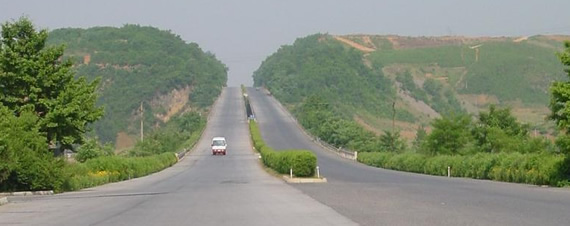 Road to DMZ Photo courtesy Thomas St. John |
|
|
Once outside of Pyongyang we got our first extended chance to take a look at the North Korean countryside. For the most part it looked poor and treeless, with most towns located well off of the main road. Even on a beautiful summer day few people were visible working in the fields, or even walking around in the towns. The road itself was basically empty. Anyone in need of an extended nap on a large, flat surface could do a lot worse than curling up in the middle of the 'highway' south of Pyongyang. There were several obvious checkpoints along the way. For the most part we drove right by but you could see the soldiers manning the checkpoints writing something down as we passed. About halfway down we pulled over to a rest area and, while talking to the roadside guard, I watched as he jotted down the license numbers of passing vehicles. When I asked why he was writing down the info he just gave me a weird look and went about his business. I guess car theft is not a real big problem in North Korea. |
|
|
Propaganda signs praising the Kims, Juche, and following government directives (i.e. 'The Government Decides and the People Act!') could be seen along most roads in North Korea, even far out in the countryside. |
|||||||
|
As we approached 'the world's most heavily defended border', the guides stepped up the warnings about not taking pictures without asking, staying with the group, listening to the on-site guides, etc. The eerie part was though we were in the middle of two million soldiers the whole area was peaceful and quiet, just like when you approach from the South. Everything is so well hidden, at least when tourists are about, you would never know you're surrounded by two giant armies. As we got closer to the border I kept sneaking looks at my cell phone to see if we were within range of the South Korean service area. With the guides milling around the bus this probably wasn't too bright but I figured the risk was outweighed by a chance to make an 'illegal' phone call. So far, no connection. Maybe I just had to get closer . . . |
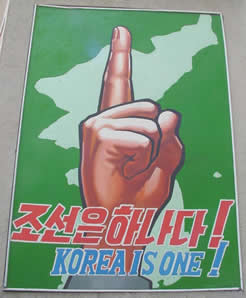 Large road sign heading to DMZ Photo courtesy Thomas St. John |
||||||
|
I quickly headed for the restrooms to hide out and give my phone another try. Memo to SK Telecom: Your service is WEAK! My friend using another carrier was able to get a signal and put a call through to his girlfriend. I was left holding a hunk of useless plastic. After risking arrest for trying to make phone calls we headed back to the group, narrowly missing getting caught by one of the guides heading into the bathroom. When we got back to the group we were soon herded into a small meeting room for a 'briefing' on the situation in the DMZ and JSA (Joint Security Area, also the name of a wildly popular movie in South Korea). Gathered around a large model of the area we were given a little background on what the area is for (meetings and exchanges between the North and South, the North and UN/US, etc.), its layout and where we would be going on our tour. I was happy to see we would be going right up to the border, even entering the same building straddling the dividing line that most of us had visited from the South. I was finally going to be able to see the flip side of a very unnatural coin. |
|||||||
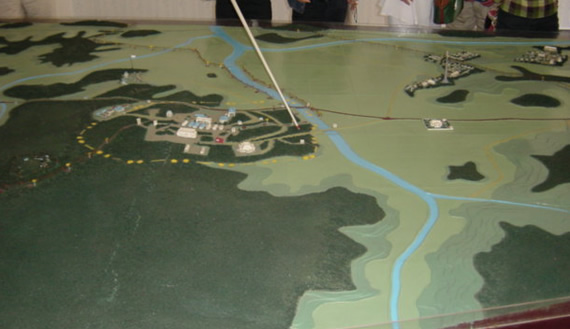 Getting our briefing before heading into the DMZ Photo courtesy Dan Harmon |
|||||||
|
|
|||||||
|
The pictures above were taken from the steps of the main North Korean building overlooking the Joint Security Area (also sometimes referred to as Panmunjom). The large building opposite is in South Korea. The soldiers in the gray uniforms at the top are South Korean, those in the brown uniforms below are from the North. The UN blue buildings are half in the North, half in the South and are used for meetings between the two sides. I'm standing about an hour from my home in downtown Seoul and less than 15 meters from the South. Going any further is illegal and would probably get me shot. The only way across that line was via China. Memo to those (i.e. the US military's USO) who run the tour from the South Korean side: Notice how we are wearing shorts and t-shirts? Even sandals?!? Why is it that on "Freedom's Frontier" (as the Southern side of the border is endlessly referred to during the US tour) there is such a rigid dress code? Is wearing a pair a shorts on a hot summer day really so subversive? The irony of having more choice in the North is ridiculous. |
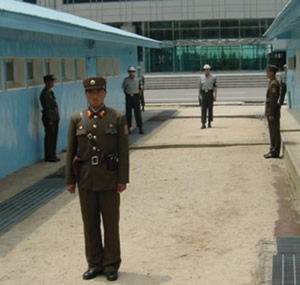 Close-up North-South Divide Photo courtesy Dan Harmon |
You can see here how close the guards get to one-another. Later I asked one of the guards with us in the bus if he ever said anything to the Southern guy while he was standing there. "No!" Not even swearing at them? "No! It's against the rules." I'd be curious to find out how truthful that was. At this range, who would ever know? One key point of the picture to the left is the guard standing in the center. He's there to keep us from making a quick dash across the line to defect. Something that actually happened during the Cold War when a Soviet tourist ran across in a hail of gunfire. |
||||||
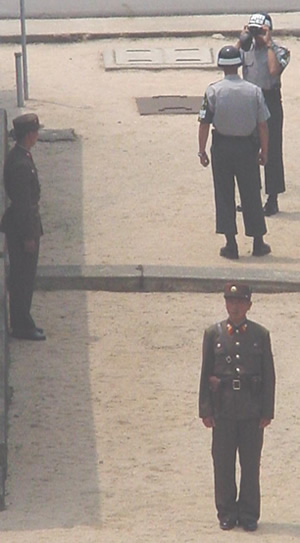 Taking a picture of us taking photos . . . Photo courtesy Thomas St. John |
The soldiers on the South Korean side seemed very interested in what we were doing. If you go from the South then you have troops from the North taking your picture and looking you over. Now it was our turn to be on the opposite side of the line and have the South photograph us. One of the people in our group was wearing a South Korean soccer shirt (the World Cup had just started a few days before we left) and that really got the attention of the South Korean guards. The only way he could have gotten that shirt was by going, very recently, to South Korea. They paid so much attention to him he was actually pretty worried something would happen when we went through customs back in the South (everything went fine). After being given plenty of time (for a change!) for pictures from the outside we were taken into one of the blue buildings to see where North-South meetings actually took place. It's the exact same building you visit when you go on the trip in the South. The only difference is there are two North Korean guards standing in front of the door to keep you from defecting! |
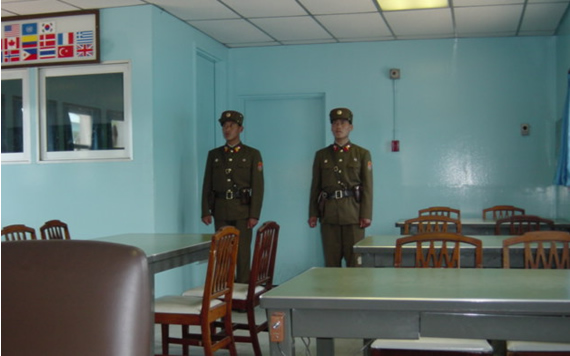 Inside the main building where North-South and North-UN discussions are held. Photo courtesy Dan Harmon |
|||||||
|
|
|
While in the room you are allowed to wander freely from one side to another, in effect walking back and forth between North and South Korea. Were that it was so easy all of the time . . . You know where the dividing line is because a long table goes across the exact center of the room. Down the exact center of the table is a thick microphone cord that shows the precise boundary between the two sides. Everything seems to be measured right down to the last centimeter, with both sides getting exactly the same space, furniture, microphone setup, etc. While inside you can have a seat at the table where the delegates sit during meetings. You are also treated to the spectacle of South Korean guards peering into the building - just like North Korean guards do when you take the tour from the South. Again, they were mainly interested in the guy wearing the South Korean soccer jersey. Since the windows are basically soundproof any ideas of talking to them were out of the question. After a few minutes looking around and snapping pictures inside the building we were hustled out and taken back into the main North Korean building that overlooks the area. That's where we were able to get a lot of these pictures. That's also where Mr. Huk and I nearly got into a fight . . . |
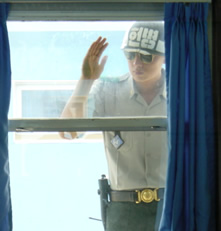 Photo courtesy Dan Harmon 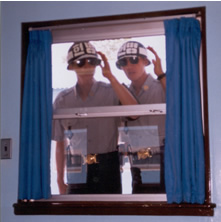 SK soldiers checking us out. Photo courtesy Thomas St. John |
|
- on an interesting side note the North Korean soldier pictured here to my right, who served as our main guide in the JSA, is one of the higher-ranking NK soldiers in the area. I've caught a glimpse of him on the news several times since the trip whenever there's been a story about someone going across the DMZ in Panmunjom. |
|
|
The building I'm standing in front of here is directly opposite the large South Korean building pictured above in the photos looking south. The picture to the right is from one of the visitor's rooms inside that building. Why is this important? What does it have to do with me nearly getting into a fight with one of the guides? The key is to show that this building I'm standing in front of is actually a real building. The first time I took the DMZ tour from the South, and on some tours since, the US soldier leading the tour would tell everyone we weren't looking at a real building. Instead the North's building was "a facade designed to look large and impressive, but is in reality only a frame a few feet (one meter) thick." As the only view of the building at that time was from the front there was no way to confirm the thickness. Unless you visit the North . . . While looking over the area from the balcony I told Mr. Huk the story I had heard about the building during my first tour on the Southern side. About how we weren't actually standing in a 'real' building. |
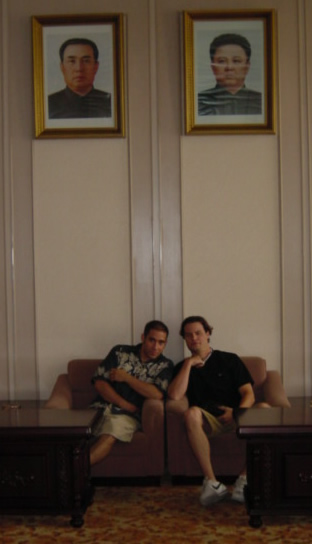 The two Kims watching over the main visitor's room overlooking the JSA Photo courtesy Thomas St. John |
|
His reaction was immediate and will forever serve as my personal definition of 'venomous'. "Now you can see the lies! The lies of the American imperialists and their South Korean puppets!" He literally spat this out. Foam flew from his lips he was so incensed. "Someday you will discover the truth about everything! They only tell you lies! Lies!" "Ah, yes Mr. Huk, there are many lies in the world. I hope I'm there when you discover the truth also." I decided to have a little fun. My words had him bug-eyed with rage. Veins popped from his forehead. "Me?! It is YOU who needs to discover the truth. I already know the truth!" "There are many truths. I hope we are together when they are ALL discovered." At this point he'd lost self-control and was right in my face, screaming in a frustrated combination of English and Korean. "You don't know what you are talking about! WE know! YOU don't know!" "Yes, and there are some things we know that you don't. Hopefully I can be there when you find them out." By this point our conversation had begun to attract a lot of attention from the other guides. Even if you didn't know both languages it was very obvious something heated was taking place. That was when Mr. Baek, the more experienced guide, walked between us and urged everyone to head back inside and get on with the tour. Eye-contact broken, and reminded of 'The Schedule', Mr. Huk walked back in, obviously upset at his failure to convince me of all the lies. The main thing I took away from the whole episode was why would the US Army guides give the North this kind of ammunition in the first place? As we filed back into the room pictured above right, Mr. Huk was telling the other guides my story of 'the lies' told on the tour in the South. Though they found it interesting none of them had quite the fervor of young Mr. Huk. The main DMZ on-site guide and I had already had a couple of brief conversations and after he listened to Mr. Huk he clearly found my story interesting and, for some reason, evidence of some kind of 'trustworthiness'. After a couple more questions about the South he asked me to sign their guestbook. Which, from the way it all came about, was not something he normally asked. At this point one of our normal guides, the one most obviously a Worker's Party official assigned to overlook things, warned everyone to be careful. "You never know what an American might write in that thing." When the DMZ guide went ahead and led me over to the book a little crowd of guides and soldiers gathered around to make sure I wasn't writing anything negative. I decided against the 'down with your idiot dictator' line and instead wrote something about hoping for a quick and peaceful unification. The fact that I wrote it in Korean (and thankfully didn't make any stupid spelling mistakes) went over very well. The main DMZ guide gave me a pat on the back and a handshake. And then kept talking to me about the South and the US presence there. "When do you think the US soldiers will leave so we can have unification?" "Well, the South's a democracy. I guess when they vote to kick us out we'll leave." "Still, doesn't the fact they haven't done that yet show you how they really are American lackeys?" "Either that or it shows they don't want you invading them again." This last comment got me an amused smirk. It was obvious we both wanted to continue the conversation in a less crowded setting but for now it was not to be. This guy, probably in his mid-40s, had obviously had a lot more exposure to the outside world than any of our much younger guides. I found out later that guards along the border could, most likely very secretly, pick up South Korean broadcasts. Unfortunately 'The Schedule' once again intruded and we had to move on, before continuing what might have been an interesting conversation. |
|
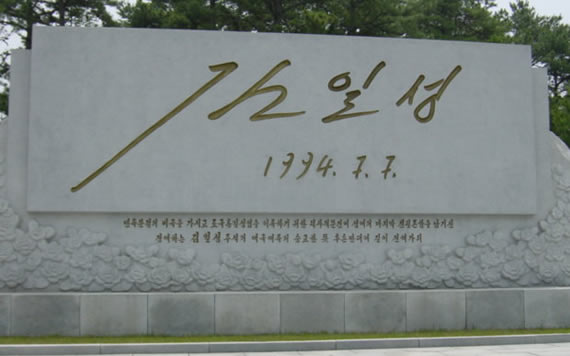 Large plaque commemorating Kim Il-sung's visit to the JSA shortly before he died Photo courtesy Dan Harmon |
|
| The other part of our DMZ tour included visits to the building where the armistice ending the Korean War was signed, plus a visit to a small museum presenting the North's view on the war and subsequent life along the DMZ. All this was led by the main DMZ guide I was getting to know, with translations provided by our normal guides. | |
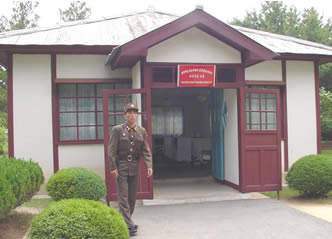 Korean War-era building for peace talks - the red sign also says the place was graced by the presence of Kim Jong-il. Photo courtesy Thomas St. John |
This part of the tour was interesting for getting a better handle on the North's view of the war and its role in it. The museum allowed them to put their own perspective on the war, who started it, how it ended and what's taken place since. The wackiest idea here is that the US and South have erected a giant, unscalable wall across the entire peninsula on their side of the DMZ. Oddly, I have yet to see or hear of this mysterious wall during my 10 years in Korea. Now why would the North want to tell its people there's a wall between them and the South . . . |
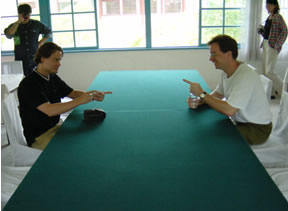 Table where ceasefire was finally signed Photo courtesy Thomas St. John |
The 'American imperialists are to blame for everything bad' line was laid on pretty thick during this part of the tour. Always with the aside that it was the US military they hated, not the American people. As if the US military is not made up of American people. Most of us had lived in the South long enough to have heard both sides but for the Japanese and Chinese on the tour there was nothing to balance the North's version. We got some very nasty looks on this part of the trip. |
|
The translation is quite interesting: It
was here on July 27, 1953 that the American |
|
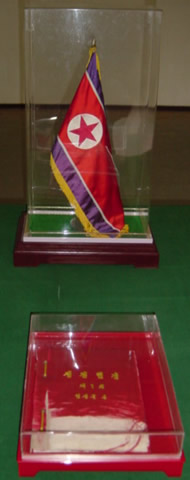 North Korean Flag Photo courtesy Dan Harmon |
Here you can see the ceasefire agreement and flags of the North Korean and UN armies (no sign of a Chinese flag for their army). On the left is the North Korean flag and the ceasefire agreement in Korean, while on the right is the UN flag and the agreement in English. The key is to look carefully at the two flags. The guides enjoyed pointing out that even though it had been 50 years since the war ended the colors of the North Korean flag hadn't ran and were still perfect. Whereas the colors of the blue UN flag had dissolved into a mottled brown. "We have never opened the glass cases in all the 50 years they have been sitting here. It shows the strength and true character of our flag." |
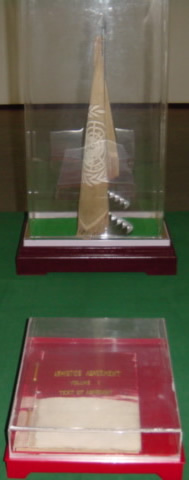 United Nations Flag Photo courtesy Dan Harmon |
|
A large part of the museum is devoted to showing US imperialism, US fault for the Korean War, US fault for the ongoing division of Korea, US fault for the sun getting in your eyes one a bright day, US fault for the rain being too wet . . . you get the idea. It was interesting to watch our two guides during all this. Mr. Huk, the younger guide on his first visit, was obviously getting rather worked up. He kept trying to, "show us the truth." Mr. Baek, the older guide, mostly seemed to be concerned with moving us along and keeping to 'The Schedule'. |
 Museum Tour Photo courtesy Dan Harmon |
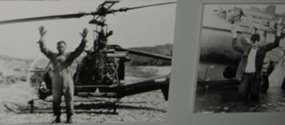 American 'infiltrators' Photo courtesy Dan Harmon |
Above you can see the guide pointing out evidence of US aggression, infiltration, etc. The pictures at the left are of Americans being captured (how did the photographers know when to be there?). No mention is made of the NK tunnels under the DMZ. Mention is made of recent joint NK-US efforts to locate the remains of MIA US soldiers. Mr. Huk was very proud of this act of kindness and was quite surprised (and then decided not to believe me) when I told him the US was forced to pay for this 'service'. |
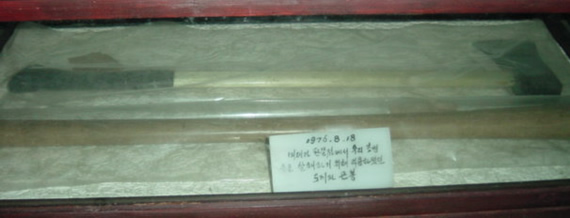 Ax from the infamous 'Tree-Cutting Incident' Photo courtesy Dan Harmon |
|
| This is the 'military ax' the North took from a group of American soldiers attempting to cut down a tree in the DMZ in August, 1976. The incident gets a lot of attention on tours from both the North and South. The Americans were attacked and two killed by a group of North Korean soldiers who used the ax and club shown above to hack and beat the US soldiers to death. The Southern tour stresses the brutality of the North, the North stresses the 'illegality' of the tree-cutting. | |
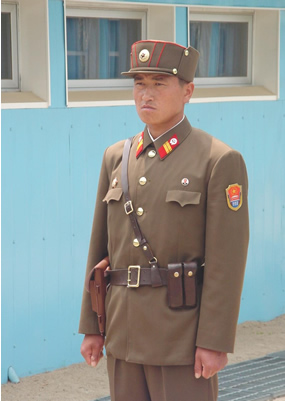 Close-up of North Korean soldier Photo courtesy Thomas St. John |
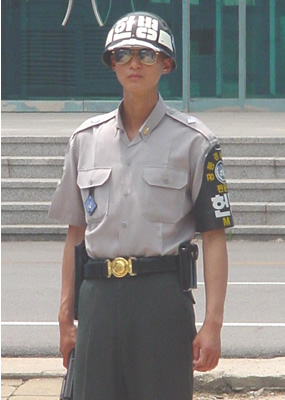 Close-up of South Korean soldier Photo courtesy Thomas St. John |
|
Notice the North Korean soldier, even on a hot summer day, wearing a long-sleeve winter uniform. While his Southern counterpart, apparently wearing a helmet borrowed from his big brother, gets to keep cool in short-sleeves and shades. If you look closely you can also see the Kim Il-sung pin over the heart of the North Korean. As the tour wound up it made everyone look forward to revisiting from the Southern side, especially to see if they were still saying we had been in a 'fake' building (they aren't). I also got a chance to say good-bye to the DMZ guard/guide I had been able to talk to during our visit. We both promised to resume our conversation again at a more propitious time. After that it was back on the bus for the short trip to the beautiful, 'traditional' city of Kaesong. |
|
| 5. Arirang Festival | ||
| Download Journey into Kimland as a single pdf (opens in new window). | ||
|
Index
|
||
| 4. Yanggakdo Hotel | ||
| 5. Arirang Festival | 6. DMZ | |
| 7. Traditional Kaesong | 8. Pyongyang Circus | |
| 9. Mt. Myohyang | 10. Kim's Birthplace | |
| 11. Departure | ||
|
-
go to 1stopKorea homepage
|
|||||||
|
Copyright 1999-2007 1stopKorea
|
|||||||